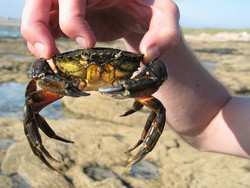On organism adaptation to salinity changes
The EU-funded IAS-LIFE (Invertebrate adaptations to salinity changes in the intertidal environment: a life-imaging approach) project investigated how intertidal invertebrate species cope with environmental changes in terms of free radical (FR) production resulting from exposure to salinity shocks. The aim was to not only characterise the generation of FRs but also to determine whether these harmful molecules aid in inducing physiological acclimatisation to environmental stress. Researchers investigated the intercellular signalling processes leading to salinity acclimatisation in intertidal invertebrates like the green crab (Carcinus aestuarii) and the flatworm (Macrostomum lignano). The redox status in both model organisms was experimentally altered by treating animals with an antioxidant solution and then exposing them to low salinity shock. The antioxidant treatment prevented antioxidant upregulation, thereby demonstrating that FRs mediate the redox response. In the specific case of the green crab, antioxidant pretreatment protected non-osmoregulatory tissue such as anterior gills from FR production induced by low salinity shock. This allowed these tissues to increase expression of membrane pumps involved in osmoregulation. IAS-LIFE results supported the hypothesis that for certain organisms or tissues, small amounts of FRs are needed to acclimatise to changes in salinity. This insight will help scientists achieve a better understanding of the mechanistic pathways behind acclimatisation that may be applied to a wide range of fields. For example, this information can contribute to new protocols for increasing stress tolerance through natural and sustainable means, thereby reducing the need for chemicals or antibiotics. The project’s findings will enable a better understanding of ecophysiological adaptation in organisms, which is crucial for realistically evaluating the impact of changing environmental conditions on both organisms and ecosystems.







